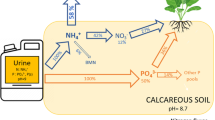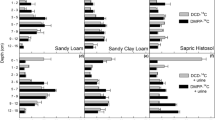Abstract
The fate of sheep urine sulphate in the soil and its plant uptake was monitored using 35S-labelled sulphate-S in undisturbed pasture microplots in two glasshouse experiments. The extent of macropore flow of simulated urine immediately following a sheep urination was also investigated at 5 pasture sites in the field.
Immediately following urination to pasture microplots in the glasshouse, the amounts of urinederived 35S recovered in the 0–2.5, 2.5–7.5, 7.5–15 and 15–30 cm soil layers were 38, 28, 18 and 9%, respectively. In the field study on 5 contrasting soils, a similar pattern was found with 55–70, 20–35 and 13–20% of simulated urine being recovered in the 0–5, 5–10 and 10–15 cm soil layers, respectively. There was insignificant loss below 15 cm. If urine had moved via simple displacement in these soils the wetting front would have reached only 2.0–2.5 cm in depth suggesting that significant downward movement of urine via macropore flow occurs after urination.
In a 15-day period following urine application to a pasture soil there was a rapid rate of incorporation of 35S into organic forms, while between 15 and 64 days the rate of incorporation declined. After 7 days, 27% of added 35S had been incorporated into organic forms with 19% being C-bonded S and 8% Hl-reducible S. This rapid incorporation was attributed to the large and active microbial biomass present in the rhizosphere. Since urine application depressed pasture growth, due to ‘urine burn’, less than 10% of applied 35S was absorbed by pasture plants over a 64-day period. A second experiment using microplots of contrasting soil types, confirmed that the majority of the 35S incorporated into the organic form was present as C-bonded S. Results showed that of the 35S remaining in the 0–2.5 cm layer 35 days after application, 20–40% was present as sulphate, 10–20% as Hl-reducible S and 50–60% as C-bonded S. Plant uptake of S accounted for only 7–12% of applied 35S over the 35-day period.
Similar content being viewed by others
References
Abdalla N A and Lear B 1975 Determination of inorganic bromide in soils and plant tissues with bromide selective-ion electrode. Commun. Soil Sci. Plant Anal. 6, 489–494.
Barrow NJ 1987 Return of nutrients by animals. In Managed Grasslands. Ed. R W Snaydon. pp 181–186. Elsevier, Amsterdam.
Bird P R 1972 Sulphur metabolism and excretion studies in ruminants. IX. Sulphur, nitrogen, and energy utilisation by sheep fed a sulphur-deficient and a sulphate-supplemented roughage-based diet. Aust. J. Biol. Sci. 25, 1073–1085.
Boswell C C 1983 An assessment of phosphorus and sulphur interactions on aspects of the sulphur cycle in pasture. Ph.D. thesis, University of New England, Australia.
During C and McNaught K J 1961 Effects of cow urine on growth of pasture and uptake of nutrients. N. Z. J. Agric. Res. 4, 591–605.
Fitzgerald J W and Andrew T L 1984 Mineralization of methionine sulphur in soils and forest floor layers. Soil Biol. Biochem. 16, 565–570.
Fitzgerald J W, Andrew T L and Swank W T 1984 Availability of carbon-bonded sulfur for mineralisation in forest soils. Can. J. Forest. Res. 14, 839–843.
Freney J R, Melville G E and Williams C H 1975 Soil organic matter fractions as sources of plant-available sulphur. Soil Biol. Biochem. 7, 217–221.
Ghani A, McLaren R G and Swift R S 1988 The incorporation and remineralisation of 35S in soil organic fractions. In Towards the More Efficient Use of Soil and Fertiliser Sulphur. Fertiliser and Lime Research Centre Occasional Report No 2. Eds. R E White and L D Currie. pp. 32–46. Massey University, Palmerston North, N.Z.
Jackman R J 1964 Accumulation of organic matter in some New Zealand soils under permanent pasture. I. Patterns of change of organic carbon, nitrogen, sulphur and phosphorus. N. Z. J. Agric. Res. 7, 445–471.
Jenkinson D S and Oades J M 1979 A method for measuring adenosine triphosphate in soil. Soil Biol. Biochem. 11, 193–199.
Kear B S, Gibbs H S and Miller R B 1967 Soils of the downs and plains of Canterbury and North Otago, New Zealand. Soil Bureau Bulletin No. 14. N. Z. Soil Bureau, Wellington.
Keeney D R and MacGregor A N 1978 Short-term cycling of 15N-urea in a ryegrass-white clover pasture. N. Z. J. Agric. Res. 21, 443–448.
Kennedy A P and Till A R 1981 The distribution in soil and plant of 35S from sheep excreta. Aust. J. Agric. Res. 32, 339–351.
Maynard D G, Stewart J W B and Bettany J R 1985 The effects of plants on soil sulphur transformations. Soil Biol. Biochem. 17, 127–134.
McLachlan K D and DeMarco D G 1975 Changes in soil sulphur fractions with fertiliser additions and cropping treatments. Aust. J. Soil Res. 13, 169–176.
McLaren R G, Keer J I and Swift R S 1985 Sulphur transformations in soils using sulphur-35 labelling. Soil Biol. Biochem. 17, 73–79.
Quin B F and Rickard D S 1981 Pasture production and changes in soil fertility on a long-term irrigated superphosphate trial at Winchmore, New Zealand. Proc 14th Int. Grassl. Congr. 323–326.
Saggar S, Bettany J R and Stewart J W B 1981 Measurements of microbial sulfur in soil. Soil Biol. Biochem. 13, 493–498.
Sarathchandra S U, Perrott K W and Upsdell M P 1984 Microbiological and biochemical characteristics of a range of New Zealand soils under established pasture. Soil Biol. Biochem. 16, 177–183.
Tabatabai M A 1982 Sulfur. In Methods of Soil Analysis. Eds. A L Page, R H Miller and D R Keeney. pp 501–538. American Society of Agronomy, Madison, WI.
Thomas R J, Logan K A B, Ironside A D and Bolton G R 1988 Transformations and fate of sheep urine-N applied to an upland U.K. pasture at different times during the growing season. Plant and Soil 107, 173–181.
Whitehead D C and Bristow A W 1990 Transformations of nitrogen following the application of 15N-labelled cattle urine to an established grass sward. J. Appl. Ecol. 27, 667–678.
Williams P H. Hedley M J and Gregg P E H 1990a The effect of preferential flow of dairy cow urine and simulated rainfall on movement of potassium through undisturbed topsoil cores. Aust. J. Soil Res. 28, 857–868.
Williams P H, Gregg P E H and Hedley M J 1990b Use of potassium bromide solutions to simulate dairy cow urine flow and retention in pasture soils. N. Z. J. Agric. Res. 33, 489–495.
Williams P H, Gregg P E H and Hedley M J 1990c Fate of potassium in dairy cow urine applied to intact soil cores. N. Z. J. Agric. Res. 33, 151–158.
Author information
Authors and Affiliations
Rights and permissions
About this article
Cite this article
Williams, P.H., Haynes, R.J. Transformations and plant uptake of urine-sulphate in urine-affected areas of pasture soil. Plant Soil 145, 167–175 (1992). https://doi.org/10.1007/BF00010345
Received:
Issue Date:
DOI: https://doi.org/10.1007/BF00010345




